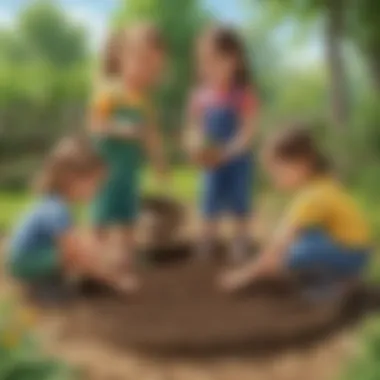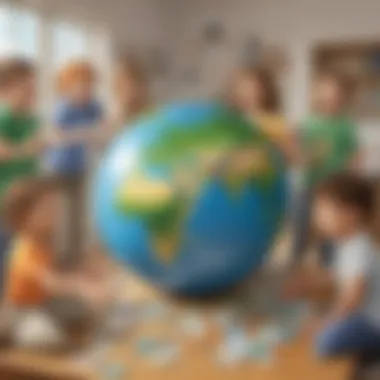Engaging Earth Day Games for Young Learners


Intro
Each year, Earth Day serves as a vivid reminder of our collective responsibility to protect and nurture our planet. For kindergarteners, engaging in playful and educational activities offers a meaningful way to understand environmental concerns. This article focuses on interesting games and activities that not only celebrate Earth Day but also instill principles of sustainability and nature conservation in young minds. The aim is to blend learning with enjoyment, fostering a sense of respect for nature early in life.
Creative Activities
Engaging children in creative activities can be an effective way to teach them about the environment. These games are designed to be fun, interactive, and educational.
Craft Ideas
Simple craft projects help children express their creativity while learning about the earth. Projects can include:
- Recycled Art: Using materials like cardboard, plastic bottles, and newspapers to create art pieces.
- Nature Collage: Collecting leaves, flowers, and twigs to create a nature-themed collage.
- Homemade Bird Feeders: Using pinecones, peanut butter, and birdseed to make feeders for local birds.
Step-by-Step Guides
- Recycled Art: Gather recyclable materials. Provide scissors, glue, and markers. Encourage children to create something unique, explaining the importance of recycling.
- Nature Collage: Before starting, take a nature walk, allowing children to collect materials. Once home, have them arrange their finds on a piece of cardboard and glue them down. This reinforces the concept of appreciating nature's beauty.
- Homemade Bird Feeders: Start with a clean pinecone. Spread peanut butter over it and roll it in birdseed. Attach a string to hang it outside. Talk about the importance of helping wildlife.
Educational Value
These activities develop fine motor skills and creativity. Simultaneously, they promote discussions about recycling, biodiversity, and the ecosystem. Children learn through hands-on experience, making the information more memorable.
Fun Quizzes
Quizzes can enhance the learning experience about Earth's environment in a fun way.
Quiz Topics
Topics can include:
- Different ecosystems
- The importance of trees
- Ways to reduce waste
Question Types
Using a mix of multiple choice, true or false, and fill-in-the-blank questions keeps children engaged. Here are some examples:
- “True or False: Trees produce oxygen.”
- “Fill in the blank: We should recycle __________.”
Knowledge Reinforcement
Quizzes act as a valuable tool to reinforce what children have learned. They help identify areas of understanding and can guide further discussion on environmental topics.
Fact-Based Articles
Providing access to informative articles can further enrich children's knowledge of the environment.
Topics
Articles can cover a wide range of subjects, such as:
- The water cycle
- Benefits of planting trees
- Understanding pollution
Engaging Content
These articles should be written in simple, clear language. Illustrations and infographics can help visualize complex concepts, making them more relatable for younger audiences.


Preface to Earth Day Games
Understanding Earth Day games is crucial for nurturing a sense of environmental awareness among young children. These games provide a platform for kindergarteners to engage with their surroundings. They also foster curiosity about nature and the various ways to protect it. A structured approach to learning through play shapes responsible future citizens.
The Significance of Earth Day
Earth Day holds great significance as it aims to raise awareness about environmental issues. Celebrated every April 22, it engages individuals and communities worldwide in understanding our ecological impact. The origins of this day date back to 1970 when it first emerged as a movement to promote environmental protection. By incorporating Earth Day into games for kindergarteners, we allow them to learn organically, making the concepts of sustainability and conservation relatable from an early age.
Why Engage Kindergarteners?
Engaging kindergarteners in Earth Day activities has multiple benefits. Their natural curiosity about the world around them can be harnessed through games that focus on environmental themes. It offers a playful way to learn key concepts such as recycling, conservation, and biodiversity.
- Development of Critical Thinking: Participating in these games helps children question their role in the ecosystem.
- Social Skills: Team-based activities promote cooperation and communication among peers.
- Physical Activity: Many Earth Day games involve movement, providing children with necessary exercise.
Encouraging young children to embrace environmental principles early on cultivates lifelong habits of sustainability. This not only benefits them individually but also impacts their broader communities.
Understanding Environmental Concepts
Understanding environmental concepts is crucial in promoting an awareness of sustainability among young children. The foundation for responsible environmental behavior starts at an early age. Teaching kindergarteners the basics of environmental awareness can inspire lifelong habits that benefit both the planet and society. Children at this developmental stage are naturally curious. They start to form their understanding of the world around them. By introducing them to environmental concepts, we help shape their values and perceptions.
Basic Environmental Awareness
Basic environmental awareness includes knowledge about nature, ecosystems, and the resources that surround us. Kindergarteners can learn about the different types of plants and animals, the importance of water, and the cycles of nature. Simple activities like storytelling or nature walks can significantly impact a child's understanding of these concepts.
- Nature Identification: Children can learn to recognize trees, flowers, and animals in their environment.
- Water Usage: Discussions on why water is essential can promote an appreciation for this vital resource.
- Recycling Basics: Simple explanations about recycling processes can introduce children to waste management concepts.
These activities encourage observation and questioning. This natural curiosity leads children to explore ways to care for their environment, increasing their engagement and learning retention.
Key Elements of Sustainability
Key elements of sustainability encompass various practices aimed at ensuring that our resources are preserved for future generations. It is important to explain concepts like reducing waste, reusing materials, and recycling in a way that resonates with young minds. Sustainability can be introduced through engaging games and hands-on activities that demonstrate these principles.
- Reduce: Teach children to minimize waste. For example, show them how to use both sides of a piece of paper before discarding it.
- Reuse: Encourage creativity by using items for new purposes. Old containers can become planters for herbs or flowers.
- Recycle: Make recycling a fun game, such as sorting recyclable materials into bins labeled with pictures.
By instilling these core principles early on, children learn to value their role in protecting the environment. Incorporating games, both indoors and outdoors, reinforces these messages, allowing for practical applications of their knowledge.
"Educating children about the environment can inspire them to advocate for change as they grow older. This lifetimes worth of habits can mean more than any single action."
In concluding this section, it is critical to stress that comprehending these environmental concepts is not merely an academic exercise. For kindergarteners, it is about fostering a sense of connection to their world and encouraging them to become stewards of the planet.
Types of Earth Day Games
Understanding the Types of Earth Day Games is crucial for creating an engaging learning environment for kindergarteners. These games serve multiple purposes, from reinforcing environmental concepts to promoting teamwork. By categorizing activities into outdoor, indoor, and creative games, we can address different learning styles and provide varied forms of interaction with nature. Educators can align each type with specific educational goals, ensuring games are not only fun but also informative. With careful selection, these games can spark interest in sustainability among young children.
Outdoor Games
Outdoor games connect children with their environment. These activities promote physical movement while teaching them about nature. They are effective in allowing children to explore and learn firsthand, making abstract concepts more tangible. Among these activities, two stand out:
Nature Scavenger Hunt
The Nature Scavenger Hunt is an engaging outdoor activity that involves searching for specific items in a natural setting. This game contributes significantly to environmental awareness by encouraging children to observe their surroundings. As they look for items like different types of leaves, flowers, or rocks, they learn to appreciate biodiversity. One of the key characteristics that make it popular is its adaptability; it can be easily modified for various locations or themes.
The unique feature of a Nature Scavenger Hunt is that it combines learning with exploration. Children not only discover new things but also develop observational skills. However, educators must consider that it requires careful supervision to ensure children’s safety while they roam around.
Planting Seeds Activity


The Planting Seeds Activity focuses on hands-on learning about growth and sustainability. Through this activity, children plant seeds, observe their growth, and understand the basics of plant life cycles. It is beneficial as it ties in the concept of nurturing the environment by growing new plants.
A key characteristic of this activity is that it instills a sense of responsibility in children. They learn that their actions can lead to positive environmental benefits. The activity uniquely emphasizes tangible outcomes—seeing a seed sprout and grow is rewarding. However, it does require patience from the children and educators alike, as growth takes time.
Indoor Games
Indoor games offer valuable opportunities for learning when outdoor options are limited. These activities can be equally engaging and stimulate critical thinking about environmental issues in a controlled setting. Two notable examples include:
Recycling Relay
The Recycling Relay is an interactive indoor game that teaches children the importance of recycling. Participants race to sort items into appropriate recycling bins. This game promotes quick thinking and teamwork. Its popularity lies in its ability to combine fun with education effectively.
The unique feature of the Recycling Relay is its dynamic pace. Children learn about various materials and their recyclability while actively participating. The challenge of speed can sometimes lead to mistakes in sorting, but this can be turned into a learning moment. Educators must ensure that children reflect on their choices, reinforcing the lesson on recycling.
Earth Day Bingo
Earth Day Bingo is another enjoyable indoor game designed to familiarize children with environmental vocabulary and concepts. Each bingo card features different elements related to Earth Day and nature. This game encourages recognition and memory, as players engage with the terminology in a playful manner.
A key characteristic of Earth Day Bingo is its flexibility; it can be adapted to various skill levels and age groups. The unique aspect is that it promotes both fun and learning through repetition of concepts. However, it may require preparation to create the bingo cards, which can take additional time.
Creative Games
Creative games allow children to express themselves while learning about environmental conservation. These activities invoke creativity and often lead to deeper discussions on sustainability. Two noted creative games include:
Art from Recycled Materials
Art from Recycled Materials encourages children to craft items using materials typically thrown away. This activity channels their creativity in a sustainable way. Participants learn to see value in items usually regarded as waste. Its key characteristic is that it fosters not only creativity but also critical thinking about consumption and waste.
A unique feature is the variety of projects that can emerge from such materials, ranging from sculptures to functional items. It allows children to showcase their individuality, while also driving home the importance of recycling. One potential disadvantage is the need for supervision to ensure safety with certain materials.
Storytelling Sessions on Nature
Storytelling Sessions on Nature offer a relaxed approach to learning about the environment. Through stories that highlight environmental themes, kindergarteners can engage their imaginations and understand concepts such as conservation and harmony with nature. A key characteristic of this activity is its ability to convey complex ideas simply and engagingly.
The unique feature of storytelling lies in its power to resonate emotionally. Children remember stories better than facts; this makes it an effective tool for lasting understanding. One limitation includes the requirement for skilled storytellers who can captivatingly engage young audiences.
Benefits of Playing Earth Day Games
Playing Earth Day games is not just a fun way to celebrate the occasion. These activities offer numerous benefits for kindergarteners. They serve as a powerful means of instilling crucial environmental values at an early age. Through engaging games, young children can develop a sense of responsibility toward nature while improving their social skills.
The games are designed to be inclusive and fun, allowing all children to participate regardless of their abilities. By fostering teamwork and collaboration, children learn to work together towards common goals. This helps cultivate a sense of community. Additionally, Earth Day games stimulate curiosity about the environment. They encourage children to ask questions, explore, and understand the natural world around them.
"Earth Day games can transform education into an interactive experience, bridging the gap between awareness and action."
Overall, the benefits extend beyond mere entertainment. They enrich the educational experience and lay a foundation for responsible behavior towards the planet. Let’s explore some specific advantages further in the next sections.
Promoting Teamwork
Teamwork is essential in today's interconnected world. Earth Day games often require children to work together. When they play games as a team, kids develop communication skills and learn to share responsibilities. For instance, during a nature scavenger hunt, they must cooperate to find items on the list. This not only enhances their social skills but also teaches them about the importance of collaboration.
In these activities, children learn to value each other's strengths and contributions. As they cheer on their teammates or offer assistance, they gain a sense of camaraderie. This social interaction is crucial during early childhood as it builds a foundation for future relationships and networking abilities. In this way, Earth Day games not only educate about sustainability but also instill profound social values.
Fostering Curiosity
Curiosity is a natural trait in young children. Earth Day games harness this innate inquisitiveness effectively. They expose children to various environmental concepts in a playful manner. For example, while planting seeds, children wonder how plants grow. This simple act leads to questions about photosynthesis, the importance of water, and the role of sunlight. Such inquiries drive them to learn more about their surroundings.


Engaging with nature enhances their observational skills. Making a nature collage from leaves and twigs prompts them to notice different textures and colors. In this context, curiosity is a pathway to deeper understanding. It cultivates a love for learning, encouraging them to explore further. Fostering curiosity through play is invaluable, as it maintains their interest in nature and environmental issues as they grow.
Integrating Earth Day Games into Curriculum
Incorporating Earth Day games into the kindergarten curriculum is a strategic method that facilitates active learning about environmental issues. It provides an interactive platform for children to engage with sustainability concepts in ways that resonate with their natural curiosities. Such games do not merely fill time but serve to instill lifelong values about our planet. When educators thoughtfully integrate these activities into their lesson plans, the potential benefits extend beyond mere amusement.
Aligning with Educational Standards
Aligning Earth Day games with educational standards ensures that learning objectives are met. Teachers are often bound by specific guidelines set by educational authorities. By selecting games that resonate with core subjects, such as science and social studies, teachers create opportunities that naturally captivate young learners. For instance, a scavenger hunt in a school garden can teach children about local flora while also fulfilling science curriculum aims about plant life cycles.
Furthermore, using playful yet structured activities helps solidify understanding. For example, when children play Earth Day Bingo, they can connect what they learn in class about recycling and conservation, thus reinforcing those concepts through repetition in a relaxing format. This method enhances retention and understanding of important environmental topics.
Creative Lesson Planning
Creative lesson planning is essential when integrating Earth Day games. Teachers should think innovatively about how to frame these activities within existing lesson content. For example, a planting seeds activity can be linked to lessons about growth, weather conditions, and ecosystem functions.
Education should not take a one-size-fits-all approach. Each classroom is unique, composed of diverse learners with varying interests. Tailoring games and activities to capture those interests can significantly enhance their educational impact. Providing choices allows children to take ownership of their learning experience and fosters an environment where they are excited to participate.
In planning, it’s also vital to consider the context of the school community. Collaborating with local organizations not only enriches the lesson but also builds a sense of belonging and community among students. Educators might reach out to local environmental groups for resources or guest speakers to enhance the experience further.
Ultimately, the integration of Earth Day games into the curriculum should be seen as an opportunity—an opportunity to connect, engage, and inspire the next generation to appreciate and protect the Earth. Educators play a crucial role in guiding young minds to understand the significance of their actions and the world around them through playful learning.
Engaging Parents and Community
Encouraging participation from parents and community members yields multiple benefits. It helps to bridge the gap between home and school, making learning a unified, ongoing process. Parents can reinforce the lessons learned in games at home, further deepening the child’s understanding of environmental concepts. This creates an impactful cycle of education that nourishes a commitment to sustainable practices. Moreover, community engagement often brings in diverse perspectives, enriching the educational experience of the children.
Overall, the inclusion of parents and the community transforms Earth Day games into a more holistic approach to environmental education, promoting attitudes and behaviors that benefit the planet.
Inviting Parental Participation
Inviting parents to participate in Earth Day activities is significant for creating a collaborative learning atmosphere. Involving parents can take many forms. Schools can host workshops where parents learn about the games and activities planned for Earth Day. These informational sessions not only educate parents but also equip them to engage with their children about environmental issues at home.
Creating opportunities for parents to join in on the activities, such as accompanying their children on a nature scavenger hunt, is essential. Such experiences can deepen family bonds while educating both parents and children. Informing parents about the importance of sustainability through engaging discussions during these activities helps them grasp the impact they can have at home.
Additionally, schools can distribute newsletters or utilize school social media platforms to share success stories from Earth Day activities. These updates can inspire more families to get involved and help sustain enthusiasm for environmental education.
Collaboration with Local Organizations
Collaboration with local organizations can greatly enrich the Earth Day experience for kindergarteners. These partnerships can provide crucial resources and expertise. For example, local environmental groups can lend materials for games or even lead educational workshops focused on wildlife preservation or recycling efforts. Such workshops can reinforce the principles of sustainability and conservation in a hands-on manner.
Organizations can also help coordinate community events, such as clean-up drives or tree planting days, allowing children and their families to engage directly with environmental issues in their neighborhoods. This kind of collaboration amplifies the educational impact, as children can see the real-world application of their learning.
Establishing a connection with local organizations enables schools to access a wealth of knowledge and resources, making Earth Day celebrations more engaging and informative. This collaboration also promotes a sense of belonging and responsibility toward the local environment among families, ultimately shaping children into environmentally conscious citizens.
Ending and Call to Action
Continued Environmental Education
Continued environmental education is vital. After Earth Day, it is important to integrate these concepts into daily learning. Incorporating discussions about wildlife, ecosystems, and sustainability into regular lessons can create a lasting impact. Educators should constantly seek age-appropriate resources to keep the information engaging. For example, using simple projects like creating a recycling station in the classroom can reinforce the concepts learned during Earth Day.
Incentivizing families to explore the outdoors together can enhance learning. Simple activities like nature walks promote curiosity about the environment. When kids share what they observe, it further solidifies their understanding. Parents and guardians play a crucial role in providing the context for these experiences. Key aspects of environmental education, such as biodiversity and climate change, can be introduced in a relatable manner. An open conversation about these topics nurtures a child's understanding and encourages critical thinking.
Encouraging Active Participation
Encouraging active participation from both children and their families is essential for continued engagement with environmental education. Schools can organize workshops or community events centered on Earth Day themes. These gatherings create a platform for families to learn together. Participation in local clean-up activities or tree planting can cultivate a sense of community and shared responsibility for the environment.
To further inspire active involvement, leaders within the educational community should recognize and celebrate the achievements of students. For instance, showcasing projects related to nature conservation nurtures a sense of accomplishment. Online platforms like Facebook can provide a space for families to share their experiences and successes in environmental stewardship. This shared space promotes ongoing conversations about sustainability practices at home.
Moreover, educators, parents, and local organizations should collaborate to create engaging programs. This partnership offers a wider range of activities and resources that can be used to engage children. The influence of comprehensive support systems can inspire the next generation to take ownership of their environmental impact.
In summary, the conclusion and call to action emphasizes the need for ongoing environmental education and active participation. The integration of these principles into daily life ensures that the lessons learned through Earth Day games are not temporary but instead, seeds for lifelong stewardship.







